Fade to Black: Melanism in Mammals
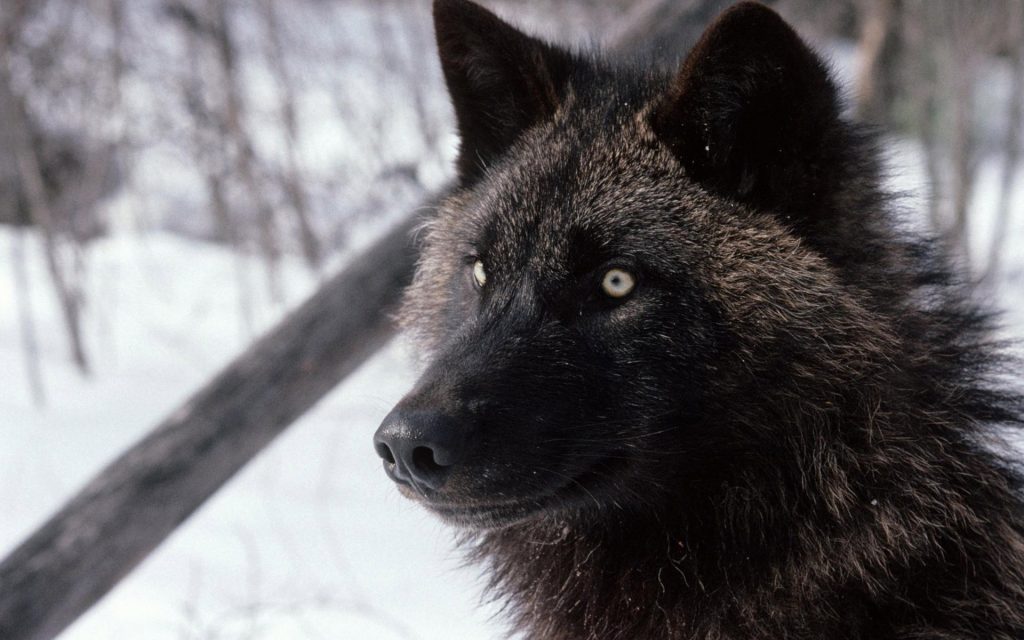
Black wolves are not uncommon in some forested landscapes, including Jasper National Park. But they are rare on the open northern tundra. ANGELL WILLIAMS
BY RICHARD SCHNEIDER
Many years ago, while on my way to the Snaring River campground in Jasper, I spotted a black German shepherd walking through a clearing at some distance from the road. The possibility that it was a wolf crossed my mind, but I quickly discounted it because wolves are not jet black. I did wonder, though, what this dog was doing wandering around by itself in the wilderness. Only later did I learn that black wolves do in fact exist, and Jasper has many of them. Mystery solved.
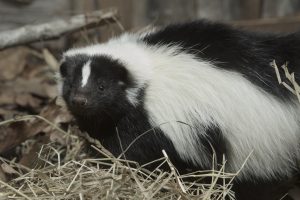
Melanism is a normal trait in several species, such as the striped skunk. The black and white striping of skunks illustrates the high level of control over colouration that mammals are capable of. CLYDE NISHIMURA
It turns out that black colouration, referred to as melanism, occurs in almost all mammals. This is no surprise when it comes to black bears and skunks. But there are also reports of black Richardson’s ground squirrels, red foxes, white-tailed deer, bobcats, and even snowshoe hares. And of course, wolves. The processes underlying these variations in colouration are quite interesting.
The Mechanics of Colouration
Compared to many other animals, mammalian coat colours are rather drab. It is no coincidence that mammals also have poor colour vision (except for primates). Why bother with the elaborate colouration of a scarlet macaw when you cannot differentiate many of the colours?
It’s not that mammals failed to evolve complex colour vision. Our reptilian ancestors actually had the ability to distinguish between four wavelengths of light (one more than humans). What happened is that some of the machinery for colour vision was lost during the earliest stages of mammalian evolution. These early mammals were largely nocturnal and needed excellent night vision rather than excellent colour vision. As far as we know, primates are the only type of mammal that has been able to regain the ability to see three wavelengths of light. Other mammals can only distinguish two wavelengths, similar to colour blind humans.
Though the range of coat colours in mammals is fairly limited, there is still plenty of variability among species. Some species are black (black bears), some are white (polar bears), some are both (skunks), and most of the rest are various shades of tan to brown. There is also variability in coat patterns, including stripes (zebras), spots (bobcats), solid colour (moose), and various mixtures of these patterns.
In mammals, one main pigment, called melanin, is responsible for the entire range of observed coat colours.1 This pigment comes in two distinct forms: eumelanin, which is responsible for dark brown or black colours, and pheomelanin, which forms yellow or reddish colours. It is the amount, composition, and arrangement of these pigment granules that produce the final result.
Although mammals have just one pigment to work with (in two forms), complex genetic machinery guides the expression of this pigment in skin and hair. Studies have determined that more than 100 genes are involved, providing plenty of scope for creative tinkering. The wide range of coat colours and patterns we observe today are the result of small genetic mutations in the pigmentation system that arose in different species after they diverged from a common ancestor.
Natural Selection at Work
Of course, there is more to the story of mammalian colouration than the random accumulation of genetic mutations within different species. Genetic mutations provide the building blocks of variability, but the genetic makeup of an organism is ultimately controlled by natural selection. This raises the question: what is it about an animal’s environment or way of life that favours one form of colouration over another?
One of the key drivers of coat colour is avoiding predation. The objective is to blend into your surroundings as much as possible. Research on the rock pocket mouse from the southwest United States reveals the hand of natural selection very clearly. Populations of this mouse that live where the local stones are predominately granite are a light sandy colour, whereas populations that live on basalt lava flows are dark to nearly black.2
Similar selection pressures exist for predators who need to get close to their prey without being seen. For example, consider a white Arctic fox sneaking up on its prey during winter, and then changing to more earthy tones during the summer to be less conspicuous.
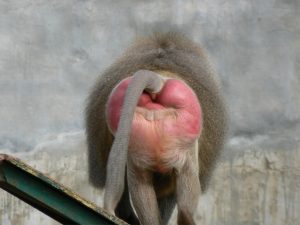
Primates can distinguish the colour red well, whereas most other mammals cannot. This is likely why red patches are used for signaling in some primates, like this baboon, but not in other mammals. PRAKHAR AMBA
The opposite approach — advertising your presence instead of hiding it — can also be of value in some cases. For example, skunks rely mainly on their powerful offensive spray for defence. Predators quickly learn to associate the striking black and white colouration of skunks with bad news and stay clear.
In many animals, particularly birds, colouration also plays an important role in communication among individuals, especially when it comes to mate selection (think peacocks). But this does not seem to be a significant factor in mammals, except for primates. Researchers believe the red skin patches and faces of many primate species may signal status among individuals. Again, it is no coincidence that this feature is found in the one group of mammals that is able to see the colour red well.
Many other questions about mammalian colouration remain unanswered. For example, black bears and grizzly bears live in similar environments and share similar lifestyles, yet one is black and one is brown. Perhaps colour is not particularly important in determining fitness in these two species. Indeed, the coats of both species come in a variety of shades. And yet, dominant colour patterns do exist, particularly at the regional scale. Why is this? The age-old question of why zebras have stripes also still lacks a convincing answer.
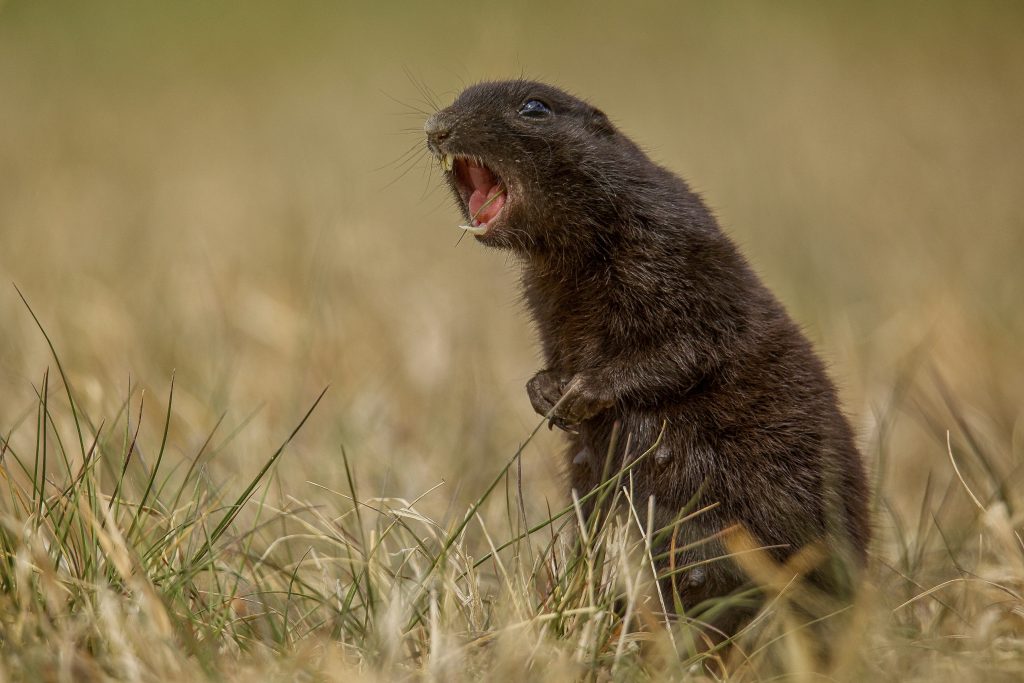
Black Richardson’s ground squirrels arise from spontaneous mutations but generally do not persist in a population because they experience high rates of predation. This individual was part of a black-coated family group found southeast of Calgary. TONY LEPRIEUR
Black Wolves and Gophers
Having explored the hows and whys of colouration in mammals, we are now ready to address the issue that motivated this article. Why are there black wolves (and other mammals)? The short answer is that the affected individuals have acquired a mutation of one or more genes controlling the pigmentation system. The basic components of the system haven’t changed, just the rules governing how they are used — like a car factory switching over from making Corollas to Camrys.
Researchers have determined that there is more than one point in the pigmentation system where a mutation can result in melanism. In many cases, such a mutation occurs spontaneously in a random individual, and so it appears to pop up in a population out of nowhere. This is the most likely explanation for the black Richardson’s ground squirrels recently observed in southern Alberta.
In other cases, the altered gene may enter a population through hybrid mating. It turns out this is what happened with our black wolves. The genetic change responsible for black fur in wolves originated in dogs, which then mated with wolves in the distant past.3 The same mutation is responsible for black coat colour in coyotes.
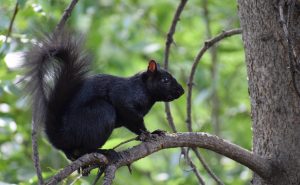
The black squirrels seen throughout Calgary are actually eastern gray squirrels with a melanistic mutation. Black squirrels seem to be able to persist in urban environments but not in rural areas. JOE PAUL
The black squirrels found throughout Calgary also have convoluted history. These are eastern gray squirrels that acquired the mutation for melanism through hybrid mating with fox squirrels in the eastern United States. Fox squirrels are not normally black either, but this is where the mutation for melanism initially arose.4 The remaining question is: how did these eastern squirrels end up in Calgary, where they are not native? In this case, human intervention was the cause. Several melanistic gray squirrels were imported in the 1920s by Tom Baines, the first curator of the Calgary Zoo, and they later made their way into the city at large.
More Natural Selection
Again, the story is not complete without considering the role of natural selection. Just because a mutation for melanism arises does not mean it will be retained. Black Richardson’s ground squirrels, snowshoe hares, and mice stand out like a sore thumb in their native environments. Odds are they will be eaten before they can successfully reproduce and spread their melanistic genes through the population. For this reason, while melanism may pop up sporadically in these species through random mutations, it usually does not persist for long.

Snowshoe hares completely change colour from winter to summer, again illustrating the high level of control over colouration that is possible. This individual is in an intermediate stage of colour change. ERIC BEGIN
In other cases, black fur can provide an advantage. Going back to our eastern gray squirrel example, researchers have found that melanism is common in many urban areas, especially in colder regions, whereas rural squirrels tend to retain their normal gray colouration.5 Clearly, the selective pressures are acting differently in these two environments, though the exact processes remain uncertain. It may be that predation pressure is less within urban areas, so cryptic colouring is less important. It’s also believed that the thermal benefit from having a black coat during cold winters may be a benefit of melanism, at least where predation is not high.
Melanism may provide a benefit to wolves, though only in some areas. Researchers have observed that dark-coloured wolves are extremely rare in the tundra and other open habitats, but increase in frequency in a southwest direction toward forested areas.3 The mechanisms are unclear but are likely to involve concealment in some way.
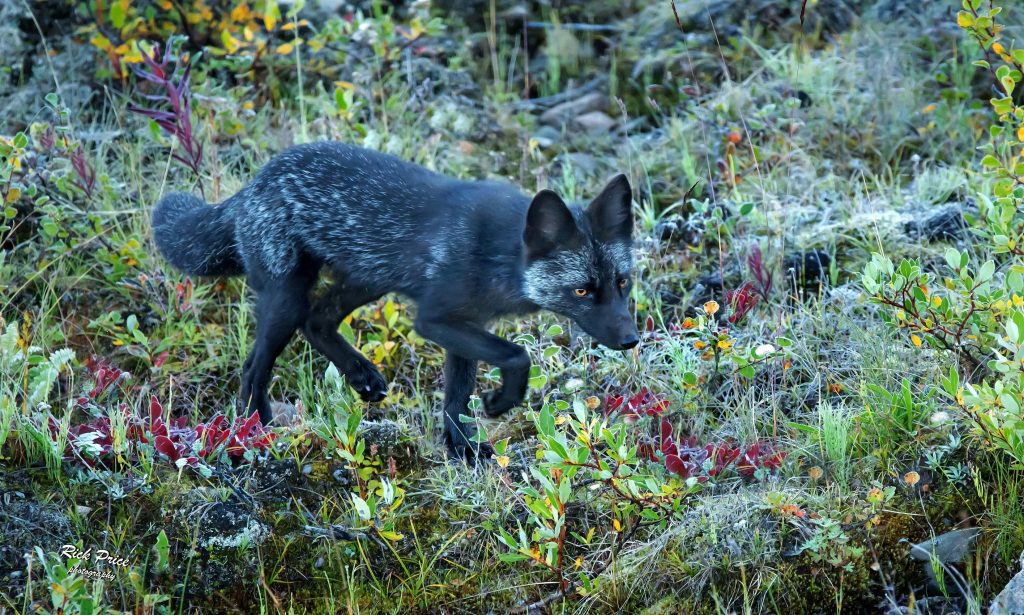
Like wolves, red foxes are sometimes seen with a predominately black coat. But also like wolves, this seems to be mostly in forested landscapes. This one was photographed in northern B.C. Black foxes are rare on the prairies. RICK PRICE
In summary, melanism provides us with another window into the amazing complexity of wild creatures and their relationship with the environment. It also vividly demonstrates that evolution is not something restricted to paleontology textbooks. It is a vital, ongoing process that continually shapes the natural world. You might bear this in mind the next time you’re traveling through Jasper and spot a black wolf, or something else out of the ordinary.
References
- Mills, M. and L. Patterson (2009). Not just black and white: pigment pattern development and evolution in vertebrates. Seminars in Cell & Developmental Biology 20:72-81.
- Majerus, M. and N. Mundy (2003). Mammalian melanism: natural selection in black and white. Trends in Genetics 19:585-588.
- Anderson, T. et al. (2009). Molecular and evolutionary history of melanism in North American gray wolves. Science 323:1339-1343.
- McRobie, H., N. Moncrief and N. Mundy (2019). Multiple origins of melanism in two species of North American tree squirrel (Sciurus). BMC Evolutionary Biology 19:1-14.
- Cosentino, B. and J. Gibbs (2022). Parallel evolution of urban–rural clines in melanism in a widespread mammal. Scientific Reports 12:1752.
Richard Schneider is a conservation biologist who has worked on species at risk and land-use planning in Alberta for the past 30 years. A new digital version of his book, Biodiversity Conservation in Canada: From Theory to Practice, is now available from the University of Alberta library, at no cost to the public. Richard currently serves as the Executive Director of Nature Alberta.
This article originally ran in Nature Alberta Magazine – Summer 2023.
